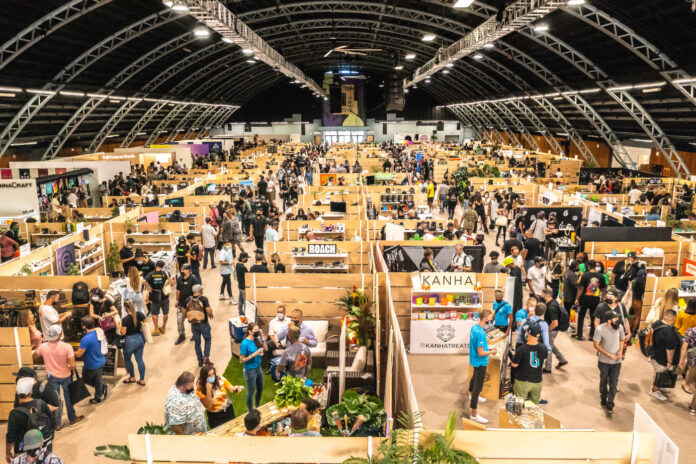SANTA ROSA, Calif. – Hall of Flowers, the business-to-business cannabis industry event known for its bold brand activations and unique on-site dispensary for retail buyers, made an impressive comeback September 22-23. The fourth iteration of the event, and the first since the COVID-19 pandemic began, took place at the Sonoma County Fairgrounds in Santa Rosa, California.
Packed with a diverse array of cannabis companies, ancillary service providers, and accessories brands, the show allowed attendees to peruse the latest and greatest the Golden State industry has to offer in three expansive expo halls. Dynamic and engaging Core Conversations also offered attendees an opportunity to explore topics such as social equity, earned media, and cultivating brand loyalty.
A lively courtyard saw many smoke-filled reunions, with cannabis professionals finally able to reconnect after lockdowns. The mood was mostly jovial and excited, conjuring images of the first day of school when people are giddy to catch up after a prolonged hiatus.
Despite the celebratory atmosphere, an elephant in the room remained. The California industry is facing a multitude of challenges including an oversupply of bulk product, wholesale pricing that continues to drop, aggressive taxation, and other regulatory turmoil.
However, the dichotomy simply showcased the continued need for the community to stick together.
“Hall of Flowers was an incredibly elevated experience,” said artist Linzy Miggantz. “After such a tumultuous time for so many and being isolated in the pandemic, the event felt like the homecoming the cannabis community needed.”
Here are three key takeaways.
The marketplace continues to evolve rapidly
The diverse mix of products on display at Hall of Flowers was nothing short of astounding. Retailers understand the changing face of the consumer markets they service, with a growing number of populations consuming the plant in more modalities than ever before. Cannabis companies have responded in a big way, targeting more use cases in a distinctive fashion.
The demand for goods beyond typical gummies and infused pre-rolls has led brands to introduce a dizzying selection of unique edibles including savory snacks and infused beverages. THC-forward flower remained a dominant force, but products with specially formulated blends of cannabinoids and terpenes are becoming more popular as consumers become more cognizant of what works for them.

The industry is ready to get back to business
If the past two years have taught us anything, it’s that the industry is gaining momentum. Sales of legal marijuana reached $4.4 billion in California in 2020, an increase of 57 percent over 2019. Consequently, both buyers and brands arrived at the event motivated to engage. The hustle and bustle throughout the show was nonstop, a welcome sight for many who wondered if the pandemic had killed trade shows for the foreseeable future.
“Gathering with colleagues at Hall of Flowers while launching our new Aviation Cannabis product brand allowed us to receive on-the-spot reactions that were exciting and important,” said Chris Lane, chief marketing officer at Airfield Supply Co. “Nothing beats [in-real-life] experiences.”
According to Ricardo Willis, chief executive officer at Hanu Labs, “The show was fast-paced, highly curated, and definitely left participants wanting more.” The company debuted its new Petra tabletop vaporizer at the event.
Many attendees reported not having enough time to achieve all their goals over the course of two days, stating their desires to keep conversations moving at the Hall of Flowers event scheduled to take place in Palm Springs in December.

Challenges remain — and can’t be ignored
Northern California enjoys a rich cannabis history unlike anywhere else in North America, but the evolving marketplace has introduced new layers of regulations, brand marketing, and corporate culture. The intersection of new-school business and old-school sensibilities on display at Hall of Flowers didn’t go unnoticed — especially by the legacy operators in the house.
“Hall of Flowers was an amazing family reunion on the one hand and also a reminder of how much things have changed on the other,” said Tina Gordon, founder and owner of Moon Made Farms. “It is a time when there’s a lot of transformation happening. It’s dynamic, and we’re still building the foundation for what will be this epic new industry built on the backs of incredible political and medical movements.”
Gordon emphasized the need for brands and consumers alike to support cultivators and raise awareness of the issues they currently face while simultaneously moving the industry forward.
“Things are really challenging for the small, heritage, sun-grown farmers, specifically,” she said. “This is who really built this entire movement, and now a lot of the farmers are unable to make it through the regulatory process. Part of that is due to the high cost of compliance and taxation, and also having the business acumen to navigate what is becoming an industry. It started as something that was holistic and organic in nature but has become something that is a system with complex and layered infrastructure.”
Looking ahead
The Hall of Flowers Experience at MJBizCon, scheduled to take place in late October, will be the show’s first event outside California. A special activation in the main hall will provide visitors with a taste of what has become California’s most popular show.
On December 8 and 9, Hall of Flowers will set up shop in Palm Springs, California for its inaugural Southern California event. Industry professionals may register online.












